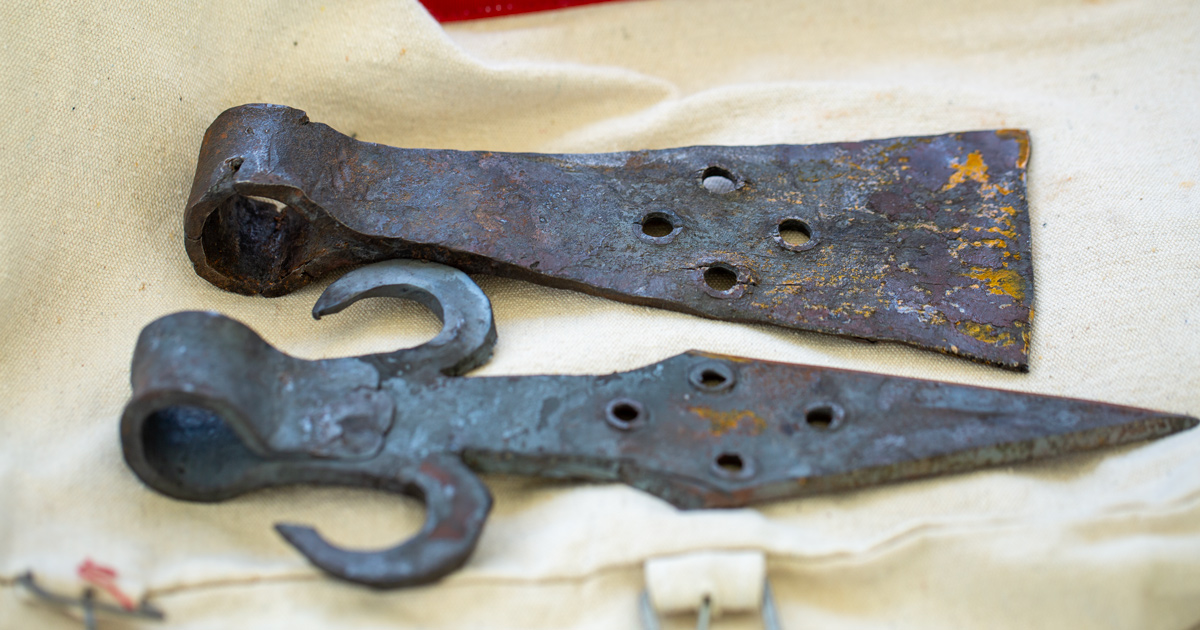On their first day out from the Knife River Villages, Clark’s hunting party struggles to travel down the frozen Missouri River. At Fort Mandan, Lewis writes about the war axes desired by the Mandans and Hidatsas.
War Axes and Scrapers
the Coal being ready for the blacksmith to work the Savages bring corn to have their war axes made & to get Scrapers to dress their buffaloe Robes with &.C.—
—John Ordway
Missouri and French War Axes
Historical interpretation by John W. Fisher and the Pacific Northwest Living Historians. Photo © 2019 by Kristopher K. Townsend. Permission to use granted under the Creative Commons Attribution-Share Alike 4.0 International license.
Top: Missouri war axe; bottom: French battle axe
Missouri Battle Axe
they [Mandans and Hidatsas] are pecuarly attatched to a battle ax formed in a very inconvenient manner in my opinion. . . . the great length of the blade of this ax, added to the small size of the handle renders a stroke uncertain and easily avoided, while the shortness of the handel must render a blow much less forceable if even well directed, and still more inconvenient as they uniformly use this instrument in action on horseback.
—Meriwether Lewis
French Battle Axe
The oalder fassion is still more inconvenient, it is somewhat in the form of the blade of an Espantoon [espontoon] but is attatchd to a helve of the dementions before discribed the blade is sometimes by way of ornament purforated with two three or more small circular holes— the following is the general figure it is from 12 to 15 inces in length
—Meriwether Lewis
Clark’s Icy Problems
The 2d day
the morning verry Cold & Windey, I broke thro the ice and got my feet and legs wet . . . . walking on uneaven ice has blistered the bottom of my feat, and walking is painfull to me—
—William Clark (recorded on 13 February 1805)
Weather Diary
State of the Ther. at rise
Weather Wind at rise
Thermt. at 4 oCk. P.M. Weather Wind at 4 oCk. P.M. River 10 [above 0] fair N W 20 [above 0] fair N W raise 1 in. visited by many of the savages today.—
—Meriwether Lewis[1]To assist the reader, the editor of this web page has omitted the date column, merged the “State of the River atrise” columns, and spelled out some abbreviations.
Experience the Lewis and Clark Trail
The Lewis and Clark Trail Experience—our sister site at lewisandclark.travel—connects the world to people and places on the Lewis and Clark Trail.
Plan a trip related to February 5, 1805:

Fort Mandan is a High Potential Historic Site along the Lewis and Clark National Historic Trail managed by the U.S. National Park Service. The North Dakota Department of Parks and Recreation manages a modern reconstruction and the Lewis and Clark Interpretive Center located at US Hwy 83 and ND Hwy 200A.
Knife River Indian Villages National Historic Site is a High Potential Historic Site along the Lewis and Clark National Historic Trail managed by the U.S. National Park Service. A unit of the National Park System, the site is located at 564 County Road 37, one-half mile north of Stanton, North Dakota. It has exhibits, trails, and a visitor center.
Notes
| ↑1 | To assist the reader, the editor of this web page has omitted the date column, merged the “State of the River at  rise” columns, and spelled out some abbreviations. rise” columns, and spelled out some abbreviations. |
|---|



